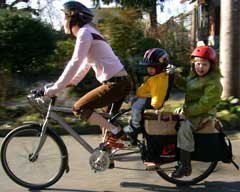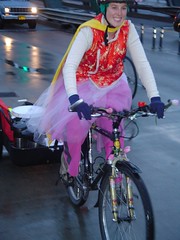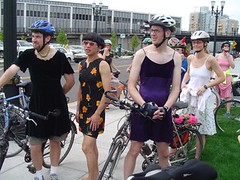Last week I ran into Natalie Ramsland of Sweetpea Bicycles at a backyard party. We both bike a lot for transportation or work, and were talking about how we choose our clothes based on their bike-worthiness.
Natalie said she chooses all her jeans by testing whether or not she can fit her U-lock in the back pocket. (She’ll even run outside to her bike to check, if the salespeople will let her.) Someone standing with us pointed out that a lot of thought goes into pocket design on women’s jeans, from a stylistic perspective. Natalie laughed, and said if she cared about that, where would she put her lock?
Women’s clothing design has come a long way down the path to equality, but I’m reminded whenever I’m looking for clothes that there’s still a ways to go. When I started to rely on my bike as my primary form of transportation, my wardrobe underwent a radical change; no more trading in comfort or utility for fashion.
Women’s gear is more often than not focused on style and body image. I have no problem with lycra shorts with built in skirts, but you’re paying a lot extra for not much utility…and they have no pockets.
Women’s bike jerseys often have shrunken pocket capacity – instead of three pockets across your back, as all men’s jerseys sport, you often get just one measly little pocket in the middle of your back. These jerseys make it possible to independently carry a pump and patch kit only if you have bags attached to your bike, or have someone else carry it for you. There is no such trend in men’s jerseys.
Many Portlanders attest that you don’t have to be unfashionable to bike. But you need clothes in which you can swing your legs, protect your feet, breathe easily, avoid entanglements with spokes and drive chain, and generally feel free.
You have to carry stuff with you, and a clutch purse won’t really do. Unless you want to carry a pannier or a messenger bag around, you need pockets. And women’s clothing is hopelessly behind in this department.
Bicycling is an integral part of the history of feminism. With the popularity of bicycling came a radical increase in women’s mobility and, necessarily, the popularity of women’s trousers (here’s a good historical essay on the topic). Mobility and clothing were tied together as liberatory issues.
Bicycling is still liberating from the traditional accoutrements – and fears – of femininity. You don’t need anyone to hold your purse or wallet or keys, or drive you home. No need to walk through empty parking lots at night or wait at deserted bus stops. If you can bike in a pair of shoes, then you can probably walk comfortably in them, too. You feel healthy, strong, and self-sufficient. And hey, you don’t need to wear blush – you’ve got a healthy glow from your trip.

Photo: Cleverchimp
Back to Natalie of Sweetpea: she designs and builds bikes specifically for women. Not because women’s bikes are so different than men’s, but because the whole bike industry is so saturated with men and men’s concerns that women are usually left to fend for themselves on those masculine terms.
The era of male chauvinism in bike shops is ending but far from over. It’s harder for women than men to meet the standard of acceptable attire at many jobs or social situations where bicycling is not the norm.
On a positive note, the percentage of women bicyclists is rising and there are new solutions for carrying children and groceries by bike. On the fun side, we have an abundance of costume rides (the Pretty Dress Ride comes to mind). At such events, Portland cyclists—who are still by a large majority men, compete to dress as impractically as possible while still being able to ride.
This excellent trend of cyclists in drag of all stripes points (in its fun-oriented, apolitical way) to the still-present gender divide and its limitations on mobility.



